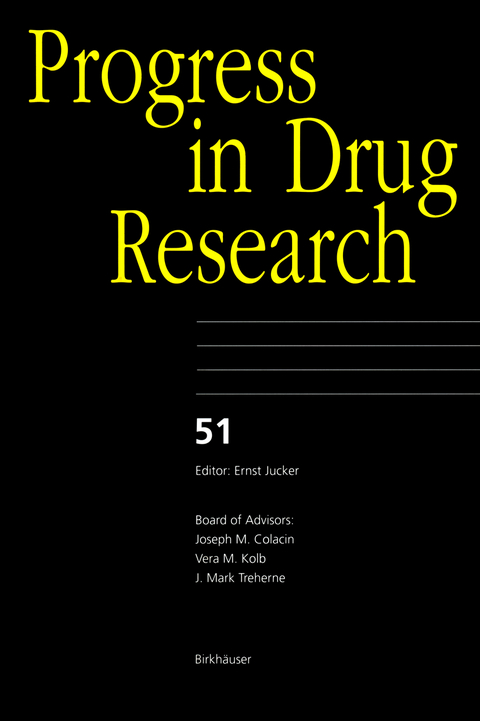
Progress in Drug Research
Seiten
2011
|
Softcover reprint of the original 1st ed. 1998
Springer Basel (Verlag)
978-3-0348-9798-3 (ISBN)
Springer Basel (Verlag)
978-3-0348-9798-3 (ISBN)
Due tothedevelopmentofdrugresistanceandotherlimitationsinthe treat ment of AIDS patients with reverse transcriptase (RT) inhibitors like zidovu dineandothers, itbecamenecessarytoexploreantiviralagentsactingontar getsotherthan RT. Inthepastfewyears, hundredsofHIVproteaseinhibitoLs have been synthesized and tested. Among these protease inhibitors, saquinavir, ritonavir, indinavir and nelfinavir have been marketed during 1995-1997. In this review, emphasis is placed on the development of HIV protease inhibitors as antiviral agents against HIV, structure-activity rela tionship (SAR) analysis ofsaquinavirand relatedcompounds, comparisonof four marketed HIV protease inhibitors, and future prospect in developing new anti-HIV drugs. 2 Introduction HIV protease inhibitors 3 HIV protease as a target for chemotherapy HIV protease was first suggested as a potential target for AIDS therapy by Kramer et a1. in 1986 [5]. HIV protease is a proteolytic enzyme responsible for cleaving large numbers of amino acid sequences. This enzyme regulates conversionoftheselargeaminoacid sequencesintobiologicallyactive struc tural and functional protein products. Specifically, HIV protease is responsi the enzymatic processing of the gagand gag-pol genes of HIV, which ble for encode for functional core proteins and viral enzymes (reverse transcriptase, ribonuclease H, integrase, and HIV protease). The polyproteins encoded by the gagand gag-pol genes undergo post-translational processing by HIV pro tease to form functional protein products as the viral particles budding out from infected cells. Therefore, inhibition of HIV protease by a protease inhibitor results in the release ofimmature, noninfectious viral particles [4].
Development of HIV protease inhibitors: A survey.- Insulin resistance, impaired glucose tolerance and non-insulin-dependent diabetes, pathologic mechanisms and treatment: Current status and therapeutic possibilities.- Peptide drug delivery into the central nervous system.- Abnormalities of protein kinases in neurodegenerative diseases.- Biomimicry as a basis for drug discovery.- Serotonin in migraine: Theories, animal models and emerging therapies.- The application of high-throughput screening to novel lead discovery.- Index Vol. 51.- Index of titles, Vol. 1-51.- Author and paper index, Vol. 1-51.
| Erscheint lt. Verlag | 12.11.2011 |
|---|---|
| Reihe/Serie | Progress in Drug Research |
| Zusatzinfo | VIII, 326 p. |
| Verlagsort | Basel |
| Sprache | englisch |
| Maße | 170 x 244 mm |
| Gewicht | 576 g |
| Themenwelt | Medizin / Pharmazie ► Medizinische Fachgebiete ► Pharmakologie / Pharmakotherapie |
| Medizin / Pharmazie ► Pharmazie ► PTA / PKA | |
| Schlagworte | AIDS • Chemotherapy • Drug • Drug research • HIV • Research • resistance • therapy |
| ISBN-10 | 3-0348-9798-7 / 3034897987 |
| ISBN-13 | 978-3-0348-9798-3 / 9783034897983 |
| Zustand | Neuware |
| Informationen gemäß Produktsicherheitsverordnung (GPSR) | |
| Haben Sie eine Frage zum Produkt? |
Mehr entdecken
aus dem Bereich
aus dem Bereich
Arzneimittelverzeichnis für Deutschland (einschließlich …
Buch | Hardcover (2024)
Rote Liste Service GmbH (Verlag)
CHF 149,95
Englisch für Apotheker und PTAs
Buch | Spiralbindung (2024)
Kohlhammer (Verlag)
CHF 44,75


